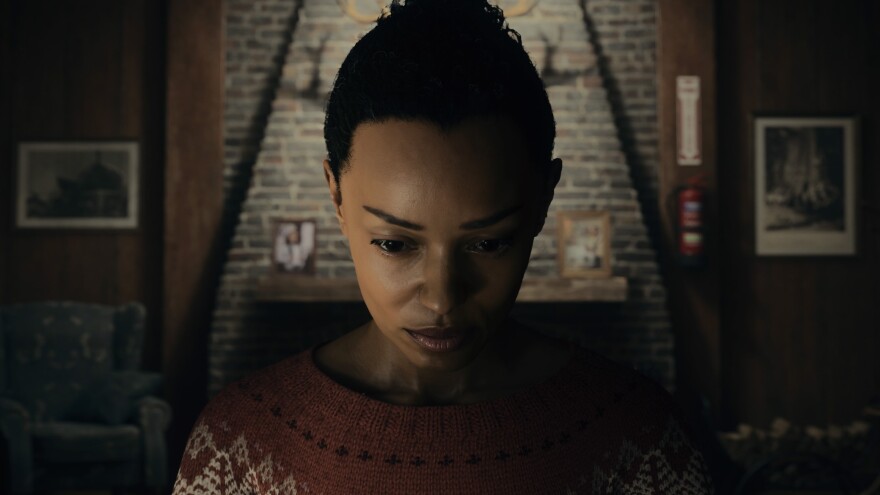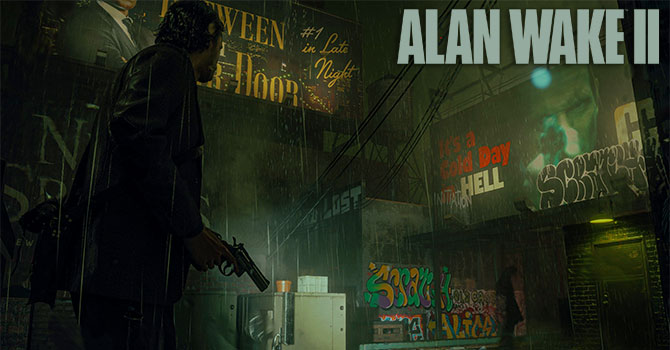Alan Wake 2 PC Review: A Ray-Traced Descent into Survival Horror Brilliance Alan Wake 2 isn't just a sequel; it's a meticulously crafted evolution of the survival horror genre.

Alan Wake 2 isn't just a sequel; it's a meticulously crafted evolution of the survival horror genre. Remedy Entertainment has doubled down on the psychological elements that made the original a cult classic while embracing modern graphical technologies to create a truly immersive and terrifying experience. This isn’t your typical jump-scare fest. It’s a slow burn that preys on your fears and leaves you questioning reality. For PC gamers who crave a smart, challenging, and visually stunning horror experience, Alan Wake 2 is a must-play. But how does it hold up under the scrutiny of a high-end PC, and what innovations does it bring to the table? Let's dive in.
Gameplay & Mechanics: Survival Horror Evolved
Remedy has taken the core of survival horror and layered on mechanics that enhance both the investigation and the inherent tension. The combat is deliberate, resources are scarce, and every encounter feels meaningful. Alan Wake 2 isn't about mowing down hordes of enemies; it's about survival.
The "Mind Place" Mechanic: A Detective's Sanctuary
One of the most significant additions to the gameplay loop is Saga Anderson's "Mind Place." This mechanic allows players to step into Saga's mind, analyze clues, profile suspects, and piece together the narrative. The Mind Place serves as a hub for investigation, allowing you to connect evidence, form hypotheses, and progress the story.

Compared to the detective mechanics in Disco Elysium or L.A. Noire, the Mind Place in Alan Wake 2 strikes a different balance. While Disco Elysium leans heavily into dialogue and skill checks to drive its investigations, and L.A. Noire focuses on interrogations and crime scene analysis, Alan Wake 2's Mind Place is more abstract and intuitive. It's less about following a linear path of questioning and more about organically connecting pieces of information to form a cohesive picture. This approach, while unique and engaging, occasionally interrupts the flow of gameplay if you get stuck trying to find the next connection. Finding the right clues requires a very specific train of thought at times.
Resource Management: A Knife-Edge Balance
Alan Wake 2's resource management is finely tuned to maintain a constant sense of vulnerability. Ammunition is scarce, batteries for your flashlight are precious, and healing items are rare. Every encounter requires careful planning and strategic use of resources. This scarcity elevates the tension, making each Taken a genuine threat.
Compared to Resident Evil 7, Alan Wake 2 leans slightly more into providing enough resources to survive, but never enough to feel comfortable. Resident Evil 7 often left players scraping the barrel, whereas Alan Wake 2 provides just enough to make calculated risks possible. This creates a more balanced experience, rewarding careful exploration and tactical combat without veering into overwhelming frustration. Is the Alan Wake 2 resource management difficult? It's fair, but unforgiving.
Narrative Analysis: Dual Perspectives, Shared Nightmare
The narrative structure of Alan Wake 2, built around the dual perspectives of Alan Wake and Saga Anderson, is a stroke of genius. Their storylines, though seemingly disparate at first, intertwine in increasingly complex and unsettling ways.
Alan Wake and Saga Anderson: Two Sides of the Same Coin
Switching between Alan and Saga offers a refreshing change of pace and allows the narrative to unfold from multiple angles. Alan's story is a descent into the nightmarish depths of the Dark Place, a reality warped by his own writing. Saga's is a grounded investigation into a series of ritualistic murders in Bright Falls, which slowly unravels into something far more sinister.

The narrative impact of switching between characters is similar to the diverging storylines in The Last of Us Part II, but with a crucial difference. While The Last of Us Part II's character switching aimed to force empathy for both sides of a conflict, Alan Wake 2's approach feels more collaborative. Each character's experiences inform and illuminate the other's, creating a richer and more complete understanding of the overarching narrative.
Atmosphere: A Masterclass in Dread
Alan Wake 2 excels at creating and maintaining a palpable sense of dread. From the rain-soaked streets of Bright Falls to the surreal landscapes of the Dark Place, every environment is dripping with atmosphere. The game masterfully uses sound design, visual cues, and pacing to keep players on edge. It walks the line between suspense and outright terror flawlessly.
Graphics: Atmospheric Immersion
Alan Wake 2 is a visual showcase, pushing the boundaries of what's possible in real-time rendering. Remedy's Northlight Engine is on full display here, creating a world that is both breathtakingly beautiful and deeply unsettling.
Lighting and Shadow: Painting with Darkness
The use of lighting and shadow in Alan Wake 2 is simply phenomenal. Light isn't just a visual element; it's a weapon, a tool, and a source of hope in the encroaching darkness. The interplay of light and shadow is particularly effective in the Dark Place, where flickering lights cast long, distorted shadows that dance and writhe with the environment. The types of light sources, from flickering neon signs to the beam of Saga's flashlight, are meticulously rendered. The quality of shadows, especially with ray tracing enabled, adds a level of depth and realism that is truly remarkable.

Photogrammetry: A World of Detail
The use of photogrammetry in Alan Wake 2 elevates the visual fidelity to new heights. Realistic textures abound, from the weathered bark of trees to the minute details of character's skin. This attention to detail significantly enhances immersion, making the world feel tangible and lived-in. The photorealistic detail is comparable to Resident Evil 7, especially in character models and environmental assets. The graphical techniques, including ray tracing and global illumination, are used to create a level of realism rarely seen in video games.
Artistic Style: Horror Through Visuals
The game's art style perfectly complements its horror themes. The environments are gritty and realistic, but with a surreal edge that reflects the distorted reality of the narrative. The character designs are believable, but with subtle details that hint at the darkness lurking beneath the surface. The overall aesthetic is a masterful blend of realism and surrealism, creating a visual experience that is both beautiful and terrifying.
PC Performance: Ray Tracing Showcase
Alan Wake 2 is undoubtedly a demanding game on PC, but the visual rewards are well worth the performance cost, especially with modern hardware.
Ray Tracing: A Visual Revolution
Testing on an Nvidia RTX 4080, Alan Wake 2 truly shines with ray tracing enabled. At 1440p, with all ray tracing settings maxed out (ray-traced reflections, shadows, and global illumination), performance hovered around 60-70 FPS without DLSS. At 4K, this dropped to around 35-45 FPS. The performance impact is significant, but the visual fidelity is breathtaking. The game is a testament to what ray tracing can bring to realism and immersion.
DLSS 3 Frame Generation: A Performance Lifeline
DLSS 3 Frame Generation proves invaluable in boosting performance with ray tracing enabled. At 1440p, enabling Frame Generation pushed the framerate to a consistent 90-100 FPS. At 4K, it brought the game into a playable 60-70 FPS range. The image quality with Frame Generation is generally excellent, with only minor visual artifacts noticeable in fast-moving scenes or when closely examining fine details.

Optimization: Room for Improvement
While Alan Wake 2 is a stunning visual showcase, the optimization could be better. Even on high-end hardware, achieving a stable 60 FPS at 4K with ray tracing requires DLSS and careful tweaking of graphical settings. The game does offer a wide range of graphical options, allowing players to adjust settings to suit their hardware. However, even with these options, some players may struggle to achieve acceptable performance on less powerful systems.
Technical Issues: A Few Bumps in the Road
During my playthrough, I encountered a few minor technical issues, including occasional stuttering and infrequent crashes. These issues weren't game-breaking, but they were noticeable and detracted from the overall experience. Hopefully, Remedy will address these issues in future patches.
Overall Experience: Love Letter to Horror
Alan Wake 2 is a triumph. It's a modern evolution of the survival horror genre that innovates and iterates on established tropes while delivering a chilling and unforgettable experience. The game draws clear inspiration from classics like Silent Hill 2, particularly in its psychological horror elements and oppressive atmosphere. The resource management and action oriented gameplay have shades of Resident Evil 4 (Remake). But Alan Wake 2 isn't just derivative; it carves its own unique path through the genre.
Final Verdict
Alan Wake 2 is a must-play for PC gamers who love survival horror. Its strengths lie in its compelling narrative, stunning visuals, innovative gameplay mechanics, and terrifying atmosphere. The weaknesses are primarily related to optimization and occasional technical issues. However, these flaws are minor compared to the overall excellence of the game. Alan Wake 2 is best enjoyed by players who appreciate slow-burn horror, intricate narratives, and challenging gameplay.
Score: 9.5/10